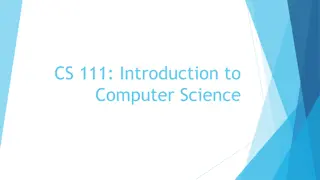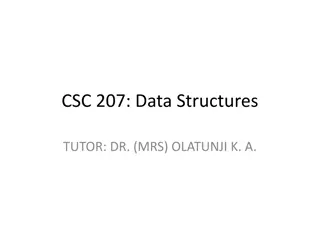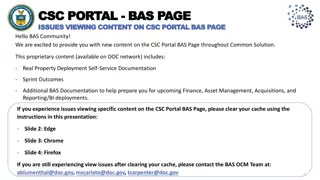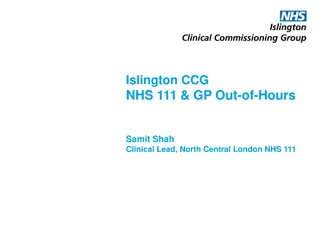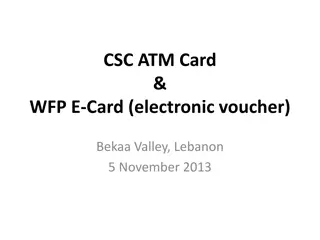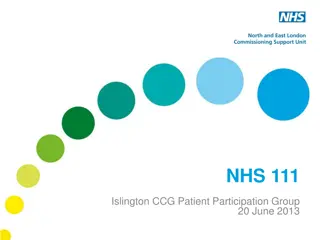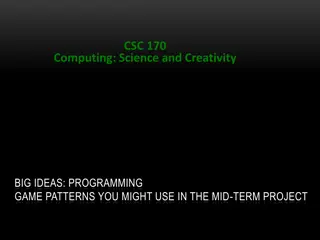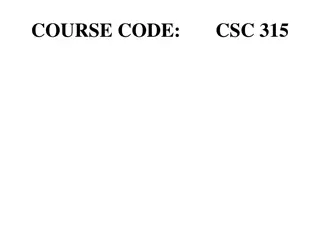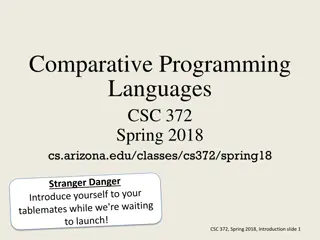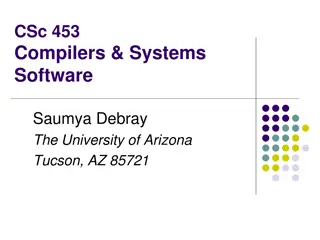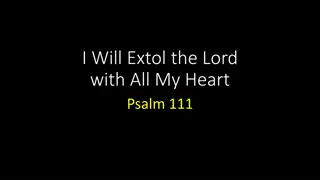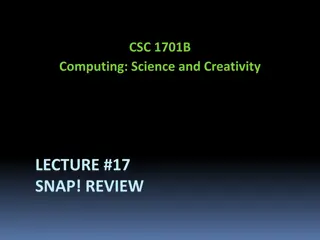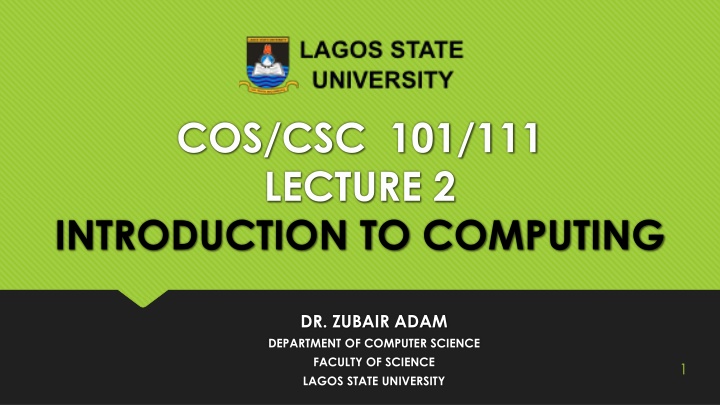
Introduction to Computing: History, Classification, and Kinds of Computers
Explore the history of computer generations, the classification of computers based on data processing abilities, and different kinds of computers - such as general purpose, special purpose, analogue, hybrid, and digital. Understand the role of computers in various applications and technological trends for the future.
Download Presentation

Please find below an Image/Link to download the presentation.
The content on the website is provided AS IS for your information and personal use only. It may not be sold, licensed, or shared on other websites without obtaining consent from the author. If you encounter any issues during the download, it is possible that the publisher has removed the file from their server.
You are allowed to download the files provided on this website for personal or commercial use, subject to the condition that they are used lawfully. All files are the property of their respective owners.
The content on the website is provided AS IS for your information and personal use only. It may not be sold, licensed, or shared on other websites without obtaining consent from the author.
E N D
Presentation Transcript
COS/CSC 101/111 LECTURE 2 INTRODUCTION TO COMPUTING DR. ZUBAIR ADAM DEPARTMENT OF COMPUTER SCIENCE FACULTY OF SCIENCE LAGOS STATE UNIVERSITY 1
OVERVIEW Introduction to & History of Computer Basic Computer Configuration Hardware (Input, Storage and Output Devices) Software (Operating System, Application Software, etc.) Internet Using personal computers as effective problem-solving tools for the present and future. Computer application areas and technological trends. 2
History of Computer Generations of computers S/N Generation Component Used 1 First Generation (1946-1954 ) Vacuum tubes 2 Second Generation (1955-1965) Transistors 3 Third Generation (1968-1975 ) Integrated Circuits (IC) 4 Fourth Generation ( 1976-1980) Very Large Scale Integrated Circuits (VLSI) 5 Fifth Generation (1980 till today ) Ultra Scale Integrated Circuits (ULSI) Micro Processor (SILICON CHIP) 3
CLASSIFICATION OF COMPUTER Computers differ based on their data processing abilities. They are classified according to i. Purpose, ii. Data handling, iii. Size, and iv. Functionality 4
KINDS OF COMPUTER (Purpose) COMPUTER GENERAL PURPOSE SPECIAL PURPOSE 5
KIND OF COMPUTER (Data Handled) COMPUTER ANALOGUE HYBRID DIGITAL 6
ANALOGUE COMPUTER Analog computers are used to process analogue data. Analog data is of continuous nature and which is not discrete or separate. Such type of data includes temperature, pressure, speed weight, voltage, depth etc. These quantities are continuous and having an infinite variety of values. 7
DIGITAL COMPUTER A Digital Computer works with digits to represent numerals, letters or other special symbols. Digital Computers operate on inputs which are ONOFF type and its output is also in the form of ONOFF signal. Normally, an ON is represented by a 1 and an OFF is represented by a 0. A digital computer can be used to process numeric as well as non-numeric data. 8
HYBRID COMPUTER A hybrid is a combination of digital and analog computers. It combines the best features of both types of computers, i-e. It has the speed of analog computer and the memory and accuracy of digital computer. Hybrid computers are used mainly in specialized applications where both kinds of data need to be processed. Therefore, they help the user, to process both continuous and discrete data. 9
KIND OF COMPUTER (Size) Mobile Computer Microcomputer Minicomputers Mainframes Supercomputer 10
KIND OF COMPUTER (Size) COMPUTER Super Mini Micro Mainframe Mobile 11
KINDS OF COMPUTER (Functionality) COMPUTER Information appliances Embedded computers Server Workstation 12
Mobile Computer Mobile computing is human computer interaction by which a computer is expected to be transported during normal usage. Being able to use a computing device even when being mobile and therefore changing location. Portability is one aspect of mobile computing. 13
Micro-Computer A microcomputer is a small, relatively inexpensive computer with a microprocessor as its central processing unit (CPU) A small, single-user computer based on one microprocessor. Microcomputers are designed to be used by individuals. 14
Mini-Computer A midsized computer. In size and power, minicomputers lie between workstations and mainframes. A minicomputer is a multiprocessing system capable of supporting hundreds users simultaneously. 15
Mainframe Computer A very large and expensive computer capable of supporting hundreds, or even thousands, of users simultaneously. In some ways, mainframes are more powerful than supercomputers because they support more simultaneous programs. But supercomputers can execute a single program faster than a mainframe. 16
Mainframe Computer (Cont) These computers are capable of handling and processing very large amounts of data quickly. Mainframe computers are used in large institutions such as government, banks and large corporations. 17
Super Computer The fastest type of computer. Supercomputers are very expensive and are employed for specialized applications that require immense amounts of mathematical calculations. An extremely fast computer that can perform hundreds of millions of instructions per second. focused on performing tasks involving intense numerical calculations such as weather forecasting, fluid dynamics, nuclear simulations, theoretical astrophysics, and complex scientific computations. 18
Computer Operations Computer is an electronic machine that performs the following five basic operations: Input Process Output Store 19
Computer Operations (Input) Input: Data is gathered/acquired Manually Automatically Both 20
Computer Operations (Processing) Processing It is the transformation process to convert the input into output. A process is an instance of running a program. It cause the computer to follow instructions from the Memory. by Central Processing Unit (CPU). 21
Computer Operations (Processing) The CPU has three parts Arithmetic / Logic Unit (ALU): The part of a computer that performs all arithmetic computations, such as addition and multiplication, and all comparison operations. Control Unit: The control unit is the circuitry that controls the flow of data through the processor, and coordinates the activities of the other units within it. Input / Output Unit (I/O): The computer components that control input and output devices 22
Computer Operations (Output) Computer Output It is the result, which comes from the transformation process or it is the outcome of the process. Anything that comes out of a computer. Example: Report Music Graphic Video clip 23
Computer Constituent Hardware is any part of your computer that has a physical structure, such as the computer monitor or keyboard. Software is any set of instructions that tells the hardware what to do. It is what guides the hardware and tells it how to accomplish each task. 24
Component of a Desktop Computer 25
System Unit The system unit is the core of a computer system. The most important of these components is the central processing unit (CPU), or microprocessor, which acts as the "brain" of your computer. Another component is random access memory (RAM), which temporarily stores information that the CPU uses while the computer is on. Almost every other part of your computer connects to the system unit using cables. 26
Central Processing Unit (CPU) The CPU, or the Central Processing Unit, is the brain of the computer and the single most important chip in the computer. The CPU performs the system's calculating and processing. 27


